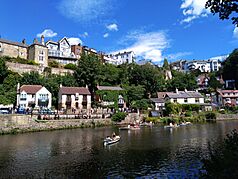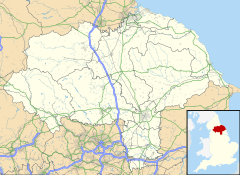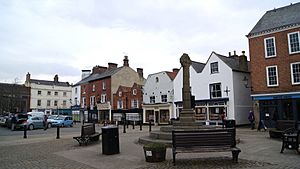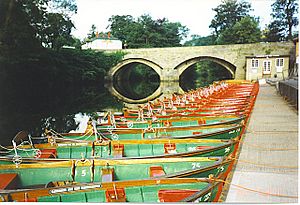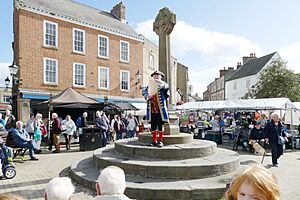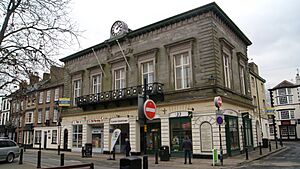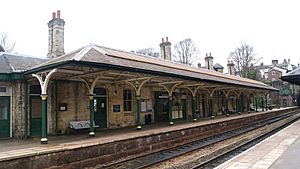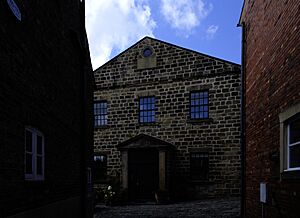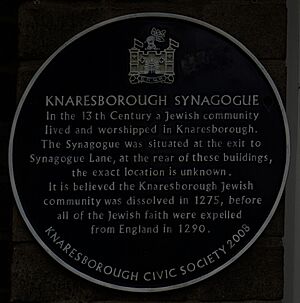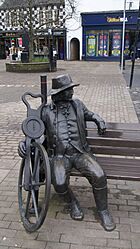Knaresborough facts for kids
Quick facts for kids Knaresborough |
|
|---|---|
| Town | |
|
|
| Population | 15,441 (2011 census) |
| OS grid reference | SE350570 |
| • London | 186 mi (299 km) SE |
| Unitary authority |
|
| Ceremonial county | |
| Region | |
| Country | England |
| Sovereign state | United Kingdom |
| Post town | KNARESBOROUGH |
| Postcode district | HG5 |
| Dialling code | 01423 |
| Police | North Yorkshire |
| Fire | North Yorkshire |
| Ambulance | Yorkshire |
| EU Parliament | Yorkshire and the Humber |
| UK Parliament |
|
Knaresborough (/ˈnɛərzbərə/ nairz-BƏR-ə) is a busy market town and spa town in North Yorkshire, England. It sits right on the River Nidd. The town is about 3 kilometres (2 miles) east of Harrogate. Until April 2023, it was part of the Harrogate Borough.
Contents
History
Knaresborough has a long and interesting past! A large collection of Roman copper pots, called the Knaresborough Hoard, was found here. It dates back to the 4th century. This shows that rich Romans lived in the area a very long time ago. Two important Roman roads, Cade's Road and Dere Street, were nearby.
The town is mentioned in the Domesday Book from 1086. This was a huge survey of England ordered by William the Conqueror. Knaresborough was called Chenaresburg, which means "Cenheard's fortress".
Knaresborough Castle was built by the Normans around 1100. This led to the town growing, as traders came to serve the castle. The main church, St John's, was also built around this time.
In 1158, a knight named Hugh de Morville was given control of Knaresborough. He was one of four knights who sadly murdered Archbishop Thomas Becket in 1170. The knights then hid at Knaresborough Castle.
Later, King John took control of Knaresborough. He even gave out the first Maundy Money here in 1210. The large Knaresborough Forest was said to be one of King John's favourite hunting spots.
Knaresborough got an official Royal Charter to hold a market in 1310 from Edward II. A market is still held every Wednesday in the town square today!
During Edward II's time, the castle was attacked by rebels. Later, Scottish invaders burned much of the town and the church. In 1328, Queen Philippa was given the castle and town. The church was rebuilt. After she died, the castle went to her son, John of Gaunt. Since then, the castle has belonged to the Duchy of Lancaster.
During the English Civil War in 1644, the castle was attacked by Parliament's army. It fell in 1646, and Parliament ordered it to be destroyed. Many town buildings were later built using stones from the castle.

The railway came to Knaresborough in 1848. The current Knaresborough railway station opened in 1851.
Knaresborough was historically part of Yorkshire's West Riding. In 1974, it became part of North Yorkshire.
Culture and community
Knaresborough is home to the Knaresborough Town Council.
One of the most famous events is the annual Bed Race. It's organised by the Knaresborough Lions Club and has been held every year since 1966. Teams race decorated beds through the town and even across the River Nidd!
Since 2001, the town has hosted an annual arts festival called the Festival of Entertainment and Visual Arts. Also, a weekly parkrun takes place every Saturday at Conyngham Hall.
Knaresborough has appeared on TV! It was seen in the comedy series The New Statesman and was a main filming location for the 2019 American TV film A Very British Christmas.
The Frazer Theatre is a local theatre near the High Street.
Landmarks
Knaresborough has many interesting places to visit:
- The ruins of Knaresborough Castle.
- The Courthouse Museum, located in the castle grounds.
- Mother Shipton's Cave, linked to a famous prophetess.
- The House in the Rock.
- St Robert's Cave, which dates back to the Middle Ages.
- The impressive Knaresborough Viaduct that crosses the River Nidd.
The House in the Rock, also called Fort Montague, is a very curious place. In the early 1800s, a child known as the "Woolly-Headed Boy" lived there. He had very unusual blonde, woolly hair. He used to show visitors around the house!
The Chapel of Our Lady of the Crag is a special shrine built into a rock face. It was built in 1408 by a mason named John. He built it after his son, who was thought to be dead in a rockfall, was found alive. John believed his prayers to Mary saved his son.
Knaresborough is also home to the oldest chemist shop in England, which opened way back in 1720!
The town has several lovely public spaces. These include the Knaresborough Castle grounds, Horseshoe Field, the King George V Playing Field, and Jacob Smith Park. Jacob Smith Park is a 30-acre park given to the town in 2003.
Conyngham Hall is near the town centre. It used to have a small zoo until the 1980s.
Near the castle are Bebra Gardens, named after Knaresborough's twin town, Bebra, in Germany.
Governance
| Knaresborough Town Council | |
|---|---|
| Type | |
| Type |
Town Council
|
| Meeting place | |
For national elections, Knaresborough is part of the Harrogate and Knaresborough constituency.
From 1974 to 2023, Knaresborough was governed by two main councils: Harrogate Borough Council and North Yorkshire County Council. These councils looked after things like housing, planning, education, and roads.
In April 2023, these two councils were replaced by one new council called North Yorkshire Council. This new council now handles all the services for the area.
At the local level, Knaresborough has its own Town Council. This council helps manage local services and represents the town's residents.
Transport
Knaresborough has its own railway station. It's on the Harrogate Line, which connects Leeds and York.
The town is about 4 kilometres (2.5 miles) from junction 47 of the A1(M) motorway. The A59 road also passes through, linking York and Wallasey.
Buses run regularly from Knaresborough bus station on the High Street. The closest airport is Leeds Bradford Airport, which can be reached by bus from nearby Harrogate.
Economy
Knaresborough is mainly a town where people live and travel to work in other places. However, it also serves as a local centre for the villages around it. The town has a small tourism industry, meaning visitors come to see its sights.
A company called Flying Colours Flagmakers is based in Knaresborough. They have a special honour called a Royal Warrant, which means they supply flags to the Royal Family!
The town has a large supermarket and smaller shops in the town centre. There's also a retail park with bigger chain stores. Knaresborough has many pubs, restaurants, and a public swimming pool.
Media
Local news and TV shows for Knaresborough are provided by BBC Yorkshire and ITV Yorkshire.
The town's local radio stations include BBC Radio York, Greatest Hits Radio Yorkshire, and 'Your Harrogate'.
Local newspapers that cover the town are the Knaresborough Post and The Press.
Religion
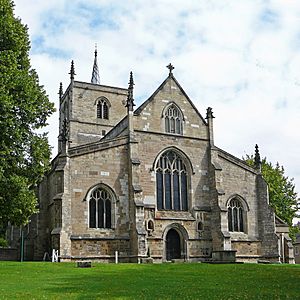
Knaresborough has several churches. These include two Church of England churches, a Roman Catholic church (St. Mary's), and Methodist and United Reformed churches.
The Knaresborough Primitive Methodist Chapel on High Street was built in the 1850s. It was later used by a coat factory before being turned into flats in 2001.
A special plaque in the Market Place remembers a 13th-century Synagogue. This shows that a Jewish community lived and worshipped in Knaresborough a very long time ago.
Education
Knaresborough has five primary schools for younger children. For older students, there is one secondary school called King James' School.
There is also a public library with two floors in the Market Place.
Sport
Knaresborough has several sports teams:
- Knaresborough Town F.C. is the local football club.
- Knaresborough Celtic and Scotton Scorchers offer youth football for different age groups.
- Knaresborough Rugby Club was formed in 1982.
- The town has two cricket clubs: Knaresborough Forest Cricket Club and Knaresborough Cricket Club.
In 2014, a famous cycling race, Stage 2 of the Tour de France, passed through Knaresborough!
Notable people
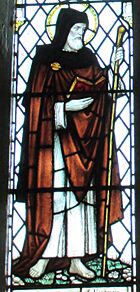
Many interesting people have connections to Knaresborough:
- St. Robert (around 1160–1218) was a hermit who lived in a cave near the River Nidd.
- Ursula Southeil (around 1488–1561), known as Mother Shipton, was a famous prophetess. She may have been born in a cave south of the town.
- John Metcalf (1717–1810), known as "Blind Jack", lost his sight as a child. He became a skilled violin player, local guide, and built many bridges and roads.
- Gorden Kaye (1941–2017) was an actor famous for playing René Artois in the comedy show 'Allo 'Allo!.
- Grant Kirkhope (born 1962) is a musician and composer who grew up here.
- Tim Kellett (born 1964) is a trumpeter and keyboardist from the bands Simply Red and Olive.
Sport
- Darren Manning (born 1975) is a motor racing driver.
- Dan Linfoot (born 1988) is a former Grand Prix motorcycle racer.
- Greg Minikin (born 1995) is a rugby league player.
Geography
 |
Boroughbridge |  |
||
| Harrogate | York | |||
| Wetherby |
See also
 In Spanish: Knaresborough para niños
In Spanish: Knaresborough para niños


